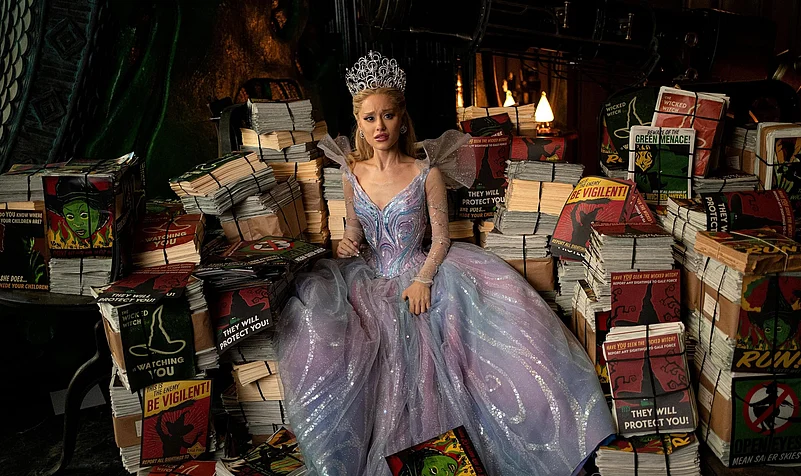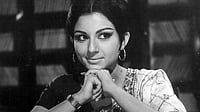
Wicked (2024) and Wicked: For Good (2025) are both directed by Jon M. Chu, who adapts the stage musical into a two-part cinematic saga.
Part Two stars Cynthia Erivo, Ariana Grande, Michelle Yeoh, Jeff Goldblum, and Jonathan Bailey in expanded, emotionally richer roles.
The sequel follows Glinda and Elphaba as Oz descends into authoritarian rule, testing their friendship while reframing the meaning of “good” and “wicked.”
Jon M. Chu’s continuation of Wicked (2024) wastes no time in setting up a premise as Wicked: For Good (2025) opens at precisely the point where the first film ended: the Yellow Brick Road is halfway built, the atmosphere already fouled by the spectacle of conscripted animal labour, and Elphaba (Cynthia Erivo) descends—broom first—to break their chains. Where the earlier chapter was anchored by Cynthia Erivo’s fierce, misunderstood outsider Elphaba, this film shifts the narrative axis toward Glinda, rendered with crisp theatrical chirpiness by Ariana Grande. The balance between the two parts, together stretching toward the five-hour mark, gains an unexpected symmetry: part one sculpts the mythology of “wickedness,” whereas Part Two reframes what “goodness” actually looks like when illusions are stripped away.
The second half of the Broadway musical has long been considered structurally loose to warrant a two-part movie series. Yet, Chu shapes it into a contained work with its own purpose. Wicked: For Good is shorter than its predecessor and a touch less extravagant in visual spectacle, even musically, as the most memorable songs belong to the first part. Yet, it gains a steadier emotional undercurrent and a more deliberate focus on internal conflict (yes, a musical can afford itself subtlety).

Michelle Yeoh’s Madame Morrible returns as the state’s quietly menacing operator, although her powers fluctuate as the story sees fit. Jeff Goldblum reprises the Wizard, and Jonathan Bailey’s charming Fiyero re-enters the story as both catalyst and romantic conflict between the two leading ladies. The film also ventures into the mythmaking of Oz, offering fresh origin threads for the Cowardly Lion, the Scarecrow, and the Tin Man—gesturing toward the larger universe without overtaking the witches’ story.
This part is quite crucial for the political spine it asserts, particularly in how it examines propaganda and the ease with which entire populations are guided into mistaking reinforced bias for truth. The Wizard, nearly deified despite possessing no real magic, maintains his authority through spectacle and persuasion. By this point, he is buckling under a soft-edged dictatorship. While the analogy is hardly delicate, it is quite functional as a narrative backdrop. His grand project—the Yellow Brick Road—symbolically invites the people to journey toward him, a manufactured pilgrimage designed to sustain his image. Yet, the very pathway meant to solidify his bond with the masses becomes the fault line that ultimately destabilises his power and pulls him off the pedestal he built for himself.

The larger thematic backbone, however, hinges on the musical’s oldest questions: What constructs wickedness? Is goodness innate or performed? Glinda embodies the contradiction perfectly in this part. She is publicly adored because she is attractive, compliant, and unthreatening. Her early instruction to Elphaba in part one—most famously encoded in the song “Popular”—equates likeability with physical charm and strategic silence in the face of discrimination. In a pointed exchange between Elphaba and Glinda in part two, Elphaba challenges her assumptions and notes quite plainly that while it may be hard to imagine “someone like him (Fiyero) falling for a girl like her,” it happens to be the truth.
Though Glinda eventually recognises the rot within Oz’s governance, her reforms remain cosmetic. She banishes the Wizard and imprisons his deputy by the finale, but the machinery of the state remains intact. Her personal journey becomes the film’s truest arc. Glinda still protects Elphaba in small, covert ways, yet she is simultaneously absorbed into the Wizard’s propagandistic machinery. Grande’s interpretation turns the former “bubble-head” (her words, not mine) into a character who finally wrestles with consequences.
A flashback to a younger Glinda—enchanted by the idea of being universally liked—reveals the origins of her political passivity. Grande’s performance reworks Glinda’s glittery and sugary confidence into something more vulnerable, especially as she undergoes a public and private reckoning that complicates her previous vanity. Her new number, “The Girl in the Bubble,” becomes the pivot: Glinda recognises that goodness without resistance dissolves into apolitical emptiness. Chu gives her space to become fully earnest and heartbreakingly human.

Elphaba, by contrast, is branded wicked for reasons that have little to do with her convictions. Her defiance of corruption is secondary to the fact that she is green—an “ugly” colour that the Wizard interprets as moral contamination. The film recognises this logic as reductive, yet it rarely interrogates it fully. This moral framework remains one of the musical’s weaker pillars, but the film’s darker tone at least sharpens the critique. The hostility she faces, rooted in prejudice rather than wrongdoing, merges with her gradual recognition of her own power. Her resilience resonates with many women of colour who will recognise the weight of being both misread and penalised.
There’s another political thread embedded in Elphaba’s song “No Place Like Home,” where she reflects on why despite all the problems, Emerald city feels singular and why her bond to it remains so unshakable. The song underscores the often-ignored truth that a homeland belongs equally to all who live in it—across communities, species, and identities—and that its people should not be displaced simply to appease the wealthy or preserve the status quo.

Despite its political scope, the most compelling element of Wicked: For Good is the recognition that, with or without the romantic subplot, their friendship remains the narrative’s heartbeat. There’s also an almost indigestible ease with which the film balances its romantic tensions while briefly decentring Fiyero to foreground the frenemy-turned-best-friend dynamic that ultimately carries the story. Many queer readings of their relationship exist, though the film’s interpretation feels comparatively restrained. Their final duet, “For Good,” remains the narrative’s anchor acknowledging the irreversibly “good” change they’ve caused in one another. Erivo and Grande, both already impressive in the first film, are given fuller dramatic range here.
Visually, the film preserves the first part’s aesthetic continuity, even as the production design occasionally feels too sleek and contemporary for a story set in a fantastical realm. The gleaming technology behind Glinda’s bubble transport or the Wizard’s oversized mechanical face doesn’t always integrate naturally with the film’s magical world-building. Grande’s ultra-chic star earrings and the synthetically polished couch or wooden doors add to this slight dissonance. Still, because the narrative never anchors itself to a specific era within Oz, these details register less as distractions and more as passing curiosities.
In all of this, Wicked: For Good ultimately argues that personal morality and public perception rarely align, and that goodness requires more than charm, compliance, or optimism. It requires confrontation. The film’s achievement lies in its ability to balance politics and intimacy without losing the unruly, melodious soul that made the original musical endure. Through its witches—one misjudged, one misguided—it suggests that the path toward moral clarity is neither linear nor glamorous, but necessary for any world hoping to free itself from illusion.



























